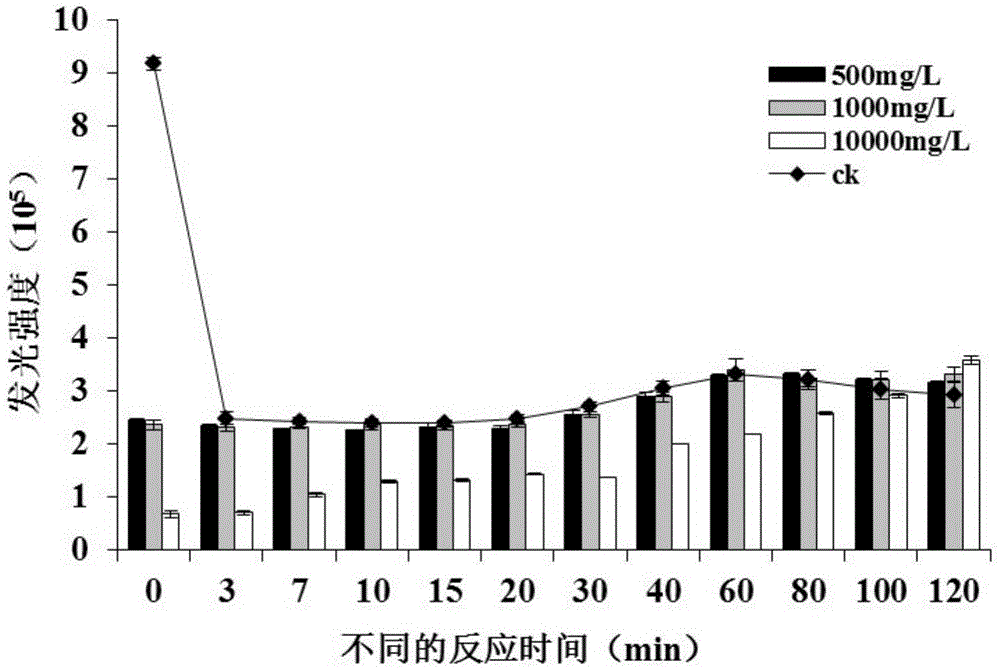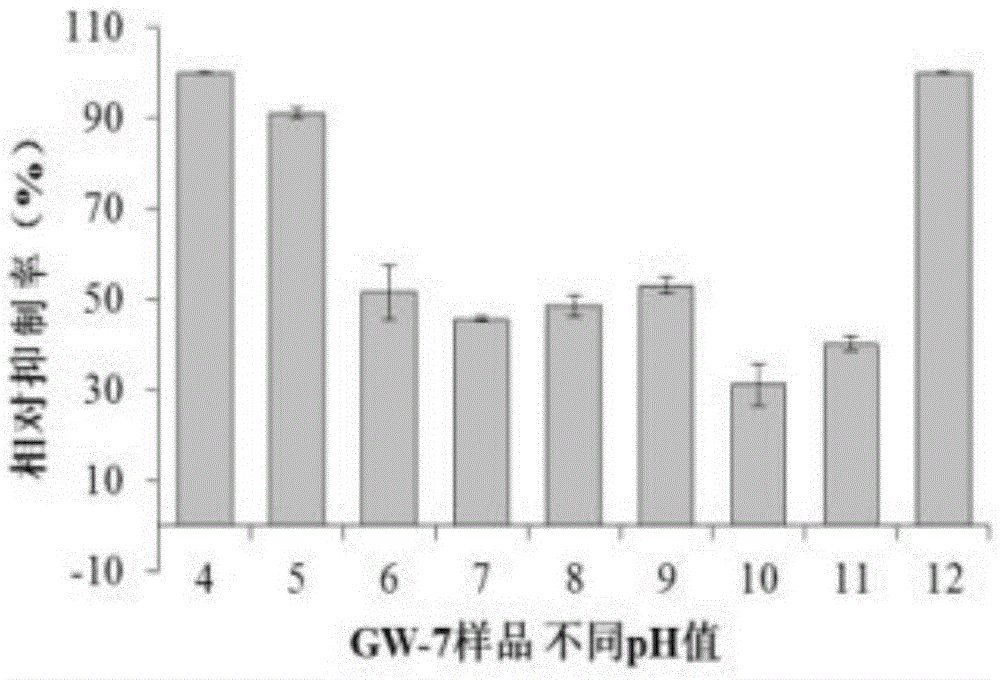Method for detecting acute toxicity of rare earth tailing pond surrounding groundwater pollution by using freshwater luminescent bacteria
A technology for groundwater pollution and light-emitting bacteria is applied in the field of environmental pollution detection and evaluation, and achieves the effects of simple and time-saving preparation, easy popularization and application, and fast and convenient testing.
- Summary
- Abstract
- Description
- Claims
- Application Information
AI Technical Summary
Problems solved by technology
Method used
Image
Examples
Embodiment 1
[0049] Example 1: Selection test of reaction time and pH value
[0050] The test optimizes the test reaction time and the applicable range of sample pH in the test method.
[0051] Separately prepare and dilute different concentrations of Na 2 SO 4 solution (500, 1000 and 10000 mg / L), on the basis of this solution, the optimization experiment of reaction time and pH value was carried out.
[0052] Reaction time optimization: Set different reaction times of 0, 3, 7, 10, 15, 20, 30, 40, 60, 80, 100 and 120min respectively.
[0053] pH Optimization: Adjust the pH of the sample to be tested to 4, 5, 6, 7, 8, 9, 10, 11, and 12, respectively.
[0054] The reaction time optimization results can be found in figure 1 , figure 1 is the effect of different reaction times on the test luminescence intensity, where CK is 0.85wt% NaCl, 500mg / L, 1000mg / L and 10000mg / L respectively represent 500mg / L Na 2 SO 4 , 1000mg / L Na 2 SO 4 and 10000mg / L Na 2 SO 4 . from figure 1 It can be s...
Embodiment 2
[0057] Example 2: Selection test of sample diluent
[0058] During the determination process, since the sample to be tested may contain a relatively high concentration of some toxic substances, the luminescent bacteria do not respond to the toxicity, and accurate detection results cannot be obtained. Therefore, it is necessary to properly dilute the sample to be tested before performing the determination.
[0059] Prepare three dilutions of simulated natural water (see Table 2 for ingredients), 0.85wt% NaCl and 10% lactose solution respectively, and prepare or dilute them into 1000mg / L Na with these three dilution solutions. 2 SO 4 solution. The relative inhibition rates of the samples in these three different dilutions were determined according to the method described above. Figure 4 . Figure 4 is the effect of different dilutions on the relative inhibition rate, in which CK is without Na 2 SO 4 The corresponding dilutions of , from Figure 4 It can be seen that the ...
Embodiment 3
[0062] Example 3: Influence test of sample turbidity
[0063] The turbidity of the sample will affect the reading of the luminescence intensity of the luminescent bacteria to a certain extent. If the sample turbidity is too large, the sample needs to be filtered or precipitated. In this example, fine sand is used, and after the sample is fully ground, it is passed through a 100-mesh sieve. Stir with distilled water for 24h and wash several times. Dilute into 14 dilution samples (ONTU-4800NTU) of different turbidity with 0.85wt% NaCl, measure the turbidity of each dilution with a turbidimeter and measure the light inhibition rate of luminescent bacteria according to the above method, the results are shown in Figure 5 , Figure 5 It is a graph showing the effect of different turbidity of the samples on the relative inhibition rate of Qinghai solitary bacteria.
[0064] from Figure 5 It can be seen that with the decrease of the turbidity of the dilution solution, the relati...
PUM
 Login to View More
Login to View More Abstract
Description
Claims
Application Information
 Login to View More
Login to View More - R&D
- Intellectual Property
- Life Sciences
- Materials
- Tech Scout
- Unparalleled Data Quality
- Higher Quality Content
- 60% Fewer Hallucinations
Browse by: Latest US Patents, China's latest patents, Technical Efficacy Thesaurus, Application Domain, Technology Topic, Popular Technical Reports.
© 2025 PatSnap. All rights reserved.Legal|Privacy policy|Modern Slavery Act Transparency Statement|Sitemap|About US| Contact US: help@patsnap.com



